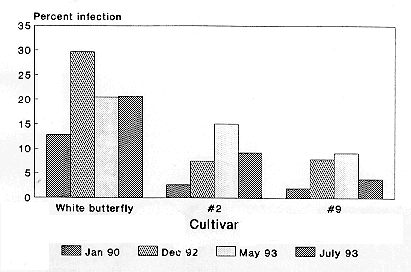
Return to: MREC Home Page
Return to: MREC Research Index
University of Florida/IFAS
Central Florida Research and Education Center
CFREC-Apopka Research Report RH-93-19
A. R. Chase 1, 2
One of the most devastating diseases of foliage plants is caused by the bacterial pathogen, Xanthomonas campestris pv. dieffenbachiae. This disease was first found in 1986 causing severe necrosis of the foliage primarily on 'White Butterfly' which has been the most widely grown cultivar for the past decade. At the time, many of the currently produced syngoniums were tested and found susceptible. No attempts were made to determine levels of resistance since none of the cultivars appeared sufficiently resistant to the pathogen. In addition, bactericides have proven ineffective in controlling the disease partially due to its systemic nature.
One method of combating this serious disease was breeding and selection of new syngoniums for resistance to Xanthomonas blight. In the early 1990's, a commercial grower selected 17 lines of Syngonium podophyllum (and other species of syngonium) for resistance to Xanthomonas campestris pv. dieffenbachiae as well as other desirable characteristics. These lines were tested at the CFREC-Apopka initially in December 1990 with two standing out as significantly more resistant to Xanthomonas than 'White Butterfly'. These two selections were propagated and three additional tests compared them to commercially available 'White Butterfly' in January 1991, November 1992 and May 1993. In each test, the two "resistant" lines showed significantly lower disease levels than 'White Butterfly' (Figure 1).
Another project was started in the late spring of 1993 to evaluate 36 lines of commercially available syngoniums for resistance to Xanthomonas. 'White Butterfly', 'Robusta' and 'Pixie' were represented by more than one source and were denoted as I, II or III. Plants were tested in August 1993. During this first test, plants became naturally infected with Myrothecium roridum, the cause of Myrothecium leaf and petiole rot, another troublesome disease on Syngonium. Both Xanthomonas blight and Myrothecium leaf spot were rated in this and again plants became naturally infected with M. roridum and developed Myrothecium leaf spot. Table 1 lists the cultivars by their level of resistance to Xanthomonas and Myrothecium.
Many of the cultivars showed different resistance levels to one or both of the pathogens when compared to the other cultivars. 'Pride' showed low resistance to both Xanthomonas and Myrothecium while 'Emerald Green' (originally from seeds) had very high resistance to both pathogens (Table 1). Other cultivars showed intermediate and sometimes different levels of resistance to the two pathogens.
Observations regarding the tendency of each selection to vine and their overall visual grade which reflected salability and consistency of the final product were also made. Nearly all of the Allusion cultivars had good to excellent visual grades and slight vining if any (Table 2). The three 'White Butterfly' selections had the highest degree of vining in addition to 'Maya Red' and 'Freckles'. Only 'Picasso' performed poorly in overall visual grade in these tests. This information should assist in development of superior plants by allowing breeders to choose cultivars with more desirable characteristics for breeding stock.
| Degree of resistance |
Cultivar resistance to Xanthomonas | Cultivar resistance to Myrothecium |
|---|---|---|
| Very low | Bold Allusion | Pixie II, Robust Allusion |
| Low | Bold, Cream Allusion, Cream Tetra, Gold Allusion, Pride | Gold Allusion, Lemon Lime, Silver Robusta |
| Some | Bob Allusion, Flutterby, Gold, Lemon Lime, Matisse, Pink Allusion, Pixie I, Robust Allusion, Silver Robusta, Wenlandii | Bold Allusion, Cream Allusion, Cream Tetra, Degas, Flutterby, Freckles, Maya Red, Renior, Robusta II, Roxanne, Wenlandii, White Butterfly I |
| Good | DaVinci, Goya, Monet, Renoir, Robusta I, White Butterfly I and II | Gold Allusion, Monet, Patricia, Pink Allusion, Pixie I, Pride, Wenlandii, Willsonii |
| High | Freckles, Holly, Patricia, Robusta II, White Butterfly III | Bob Allusion, Bold, Dali, Holly, White Butterfly II and III |
| Very high | Dali, Degas, Maya Red, Picasso, Willsonii | |
| Nearly immune |
Emerald Green (seeds), Roxanne | Emerald Green (seeds), DaVinci, Gold, Goya, Matisse, Picasso |
| Degree of vining |
Cultivar | Visual Grade |
Cultivar |
|---|---|---|---|
| None | Bold, Bold Allusion, Flutterby, Gold Allusion, Holly, Lemon Lime, Patricia, Pixie I, Pride, Robust Allusion, Robusta I, Robusta II | Excellent | Bob Allusion, Bold, Cream Allusion, Flutterby, Gold Allusion, Goya, Holly, Lemon Lime, Matisse, Pink Allusion, Pixie I and II, Pride, Robust Allusion, Robusta |
| Slight | Bob Allusion, Cream Allusion, Dali, DaVinci, Degas, Emerald Green (from seeds), Gold, Matisse, Monet, Picasso, Pixie II, Silver Robusta, Wilsonii, | Good | Bold Allusion, Freckles, Gold, Maya Red, Monet, Patricia, Renoir, Silver Robusta, White Butterfly I, II, and III |
| Moderate | Cream Tetra, Goya, Pink Allusion, Renoir, Roxanne, Wenlandii | Moderate | Cream Tetra, Dali, Degas, Emerald Green (from seeds), Matisse, Maya Red, Roxanne, Wenlandii, Willsonii |
| High | Freckles, Maya Red, White Butterfly I, II and III | Poor | Picasso |
Figure 1. Severity of Xanthomonas
leaf spot on two "resistant" lines of Syngonium
compared to 'White Butterfly'. 
1professor of Plant Pathology, University of Florida, IFAS, Central Florida Research and Education Center, 2807 Binion Rd., Apopka, FL 32703-8504.
2Special thanks to R. W. Henley for use of his syngonium stock plants and to Jeanne Yuen for her invaluable assistance in interpreting these tests.
Pesticides should
be applied according to label directions.
Regardless of the
pesticide or mixture of pesticides used, it is
strongly recommended that the effects be evaluated on a few
plants, under your particular conditions before treating all
plants.
Mention of a
commercial or proprietary product in this paper
does not constitute a recommendation by the authors,
nor does it imply registration under FIFRA as amended.
Reference to University of Florida/IFAS Pest Control Guides